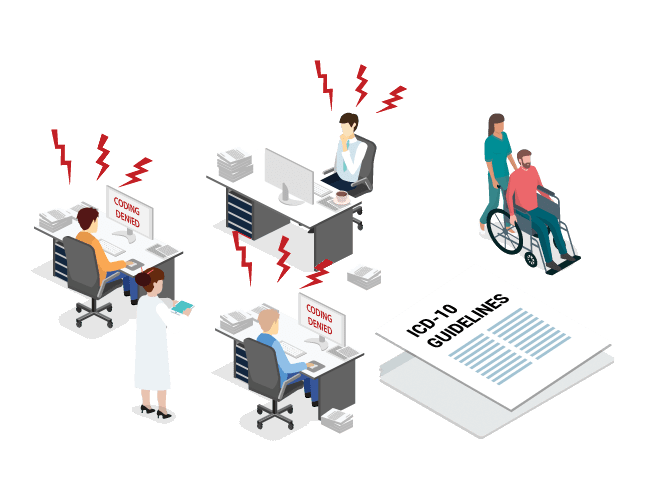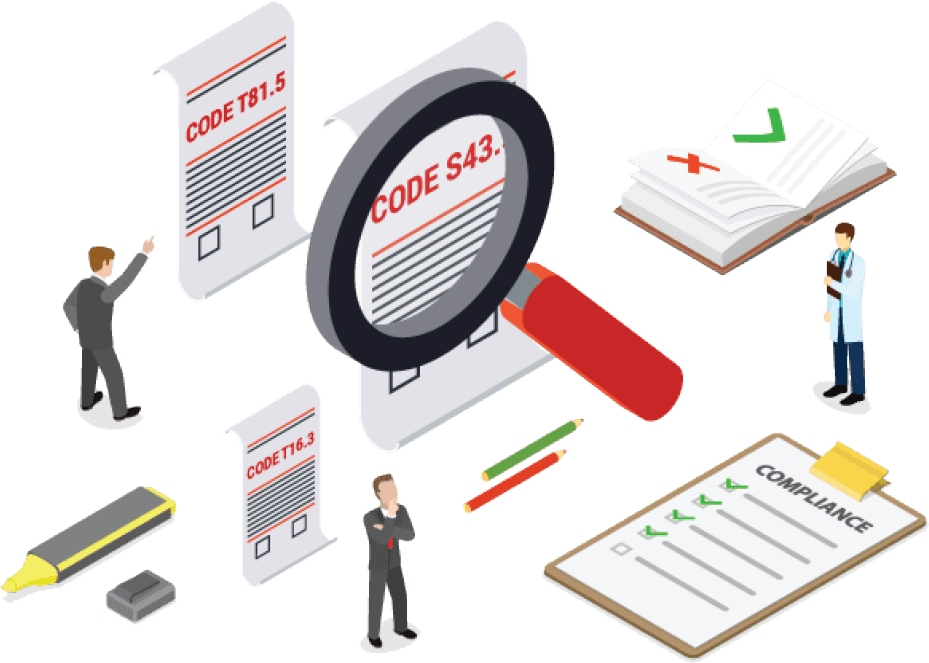White Paper
Optimizing Revenue Using a Third-Party Medical Coding and Billing Team


Executive Summary
Within the healthcare industry, providers are being impacted by increasing governmental regulations, insurance payer changes, and transitioning patient expectations. The revenue cycle management (RCM) process, including coding and billing, is where significant revenue is at risk. Practices often choose to handle these functions in-house with a mix of automated and manual systems; however, we outline a far superior structure using a third-party partner leveraging highly trained billing and coding specialists as a comprehensive solution to today’s revenue generation process.
Eclipsing Long-Accepted Standards in Revenue Collection
Providers are facing significant challenges as we enter the 2020s. Expanding oversight and regulation from government entities and insurance companies, new (or reimagined) value-based payment models, and RCM-specific issues like rising bad debt and uncollectible amounts leave provider groups searching for solid footing heading into the future.
From the macro perspective, maximizing revenue in the healthcare industry’s complex third-party payer system continues to be a challenge. With increasingly elaborate payment models and fee schedules, and escalating payer scrutiny for advanced procedures and testing, it’s never been more critical to stay current with new technological advances in the revenue payment lifecycle.
Industry-Wide Complications
To add to the complexities, according to the Healthcare Financial Management Association (HFMA), the CDC has released findings showing that 47% of commercially-insured consumers were choosing a High Deductible Health Plan (HDHP) hoping to reduce household health insurance costs by lowering premiums.1 This shift in financial responsibility from government and private insurance payers to consumers has made it imperative for practices to embrace new technology or risk precious margin on the accelerated growth of bad debt.
Further, completely unexpected, along came a pandemic that has changed the way healthcare is being delivered and how it needs to be coded and billed. Telehealth, changes to laboratory testing, and reimbursement for COVID-19 care and treatment have all brought new challenges to coding and billing to ensure maximum reimbursement.2
Processes Where Third-Party Partner Support Will Enhance Practice Revenue
For these purposes, let’s define the healthcare payment lifecycle as two-fold: 1) Patient Access, including prior authorization and insurance verification, coupled with 2) Revenue Cycle Management (RCM)—coding, billing, and A/R management. By focusing on medical coding and billing, maximum efficiency can be gained, and previously lost or delayed revenue can be captured.
Let’s look at the coding and billing components and their inherent issues:
Since its release in October 2015 and the myriad subsequent changes and updates, the ICD-10 coding system presents a multifaceted and intricate set of issues, especially for specialties that utilize different care venues (practices, hospitals, imaging or testing centers) and complex diagnoses and procedure options. The balancing act of capturing charges and documentation between locations during a typical day requires juggling talents for providers and staff alike.Once a patient is seen, the first step is to determine the accurate codes and service levels. However, whether it’s due to lack of time or chart completion expectations, procedures are often under coded, miscoded, documentation is missing, or service level is misclassified. This causes severe problems that impact revenue, including denials, underpayment, and abandonment of claims.

One of the most significant pain points for practices can be projecting the billing process workflow and the inability to scale for the fluctuating workload quickly. Everything can be either overloaded or slowed to a crawl based on staffing within the billing department, from charge entry to payment posting, Staffing issues from unexpected changes in employment status, family leave requests, and hiring mis-queues can all create bottlenecks that slow down claims processing and impact bottom line revenue. This creates further problems with ancillary responsibilities, such as resolving credit balances and managing contract performance to aid future negotiations.


The Benefits of a Third-Party Partner Brings to the Coding and Billing Process
Whether a practice has an overwhelming backlog of coding that needs to be accomplished, claims that need to be processed and submitted, or checks needing to be entered — or the practice wants to establish an ongoing relationship overall — consider the benefits brought by a third-party partner poised to tame practice coding and billing.
For example, Enhanced Revenue Solutions (ERS) by Infinx presents a case study where they implemented a recovery plan for a regional multi-facility hospital and group practice leading to a 99% acceptance rate for coded claims.3 This represents a vast improvement over the group’s result with an in-house coding and billing effort.
Additionally, ERS by Infinx implemented a complete overhaul, including coding and billing for a large hospital-based cardiology clinic, improving their quarterly collections by over $1M, and raising their Medicare collections rate by 10%.4

Medical Coding
Today, it’s imperative to accentuate the process of coding to achieve accuracy and maximize the shrinking healthcare dollar. If a practice is burdened by the ongoing education- and personnel-related issues that arise with developing and maintaining a strong coding department, they may want to consider enlisting a third-party partner. A trusted outside team can absorb the workflow efficiently and code thoroughly to maximize reimbursement.
To fully capture revenue due, whether in-house or with a third-party partner, consider:
- A paramount challenge in healthcare is staying up to date on coding with ICD-10CM and PCS, CPT, and HCPCS codes through education and knowledge building. Ongoing training on updates and changes is paramount to maximize coding precision.
- Minimize human error and careless keying mistakes that can drastically affect reimbursement by implementing an accountability structure that rewards coding accuracy.
- Ensure medical documentation is not only present but accurate and complete with every patient encounter. Payers request this information and will deny claims based on inaccurate, untimely receipt of documentation, so it’s key to include the following:
- Procedures performed elaborating on medical necessity and level of care requirements,
- Physician or APP’s involvement in patient care and level of service performed,
- Tests ordered and corresponding results with treatment prescribed,
- Billable supplies and equipment used throughout patient treatment,
- Referrals, both incoming and outgoing, and
- Prior authorizations for all procedures and treatment as required by the patient’s insurance provider.
- Capture commonly missed tests that are billable or support treatment/diagnosis decisions.
- Code to the highest degree of specificity and code to the diagnosis and not necessarily the symptom
- Design and implement a review and audit of the documentation and coding process. Not only does this suggest areas for improvement which directly affect the bottom line, but it also ensures compliance with government regulations and contractual insurance payer obligations.
- Make sharing knowledge and training as it becomes available as a core foundation of organizational operations. Everyone impacted should participate in comprehensive opportunities to improve the coding and documentation program’s quality and feel a personal investment.

Medical Billing
The most effective way to address the scalability issue that often stresses the billing function is to engage a thirdparty partner that can assume responsibility for executing all aspects of the billing process. Utilizing a scalable, costeffective automated solution that manages billing complexities while meeting payer criteria ensures accurate claims are submitted, paid quickly, and denials minimized.
By engaging an off-site team to provide billing support, these functions would seamlessly resolve behind the scenes:
- Charge Entry
- Payment Posting
- Credit Balance Resolution
- Contract Management
- Analytics (designed for financial management)

The End Result for the Revenue Stream
When a practice ensures pristine coding and billing, whether through a third-party partner or an in-house department, they should recognize the maximum allowable reimbursement, reduce their overall denied claims, and improve their bad-debt collection rate. It takes considerable effort on behalf of the providers and clinical staff to provide the correct information and documentation in a timely manner (within 24 hours at a maximum).
By embracing a qualified outside coding and billing team, like ERS by Infinx, your practice or group would be able to offload the stressful day-to-day management of the complex insurance billing process and enjoy the benefits and assurances of top-dollar reimbursement.
And if you find your practice or group with a significant backlog of claims unfiled, as often happens with a change in management or personnel or following a big influx of patients (i.e., resuming post-pandemic care), ERS by Infinx can provide emergency, time-sensitive remedies to get your revenue stream back on track.
Contact us to learn more about our medical coding and billing capabilities and request a coding audit to see how we can help optimize your revenue.
About Infinx
Infinx provides innovative and scalable payment lifecycle solutions for healthcare practices. Combining an intelligent, cloud-based platform driven by artificial intelligence and automation, with our trained and certified prior authorization, coding and billing specialists, we help clients realize revenue, enabling them to shift focus from administrative details to billable patient care.




